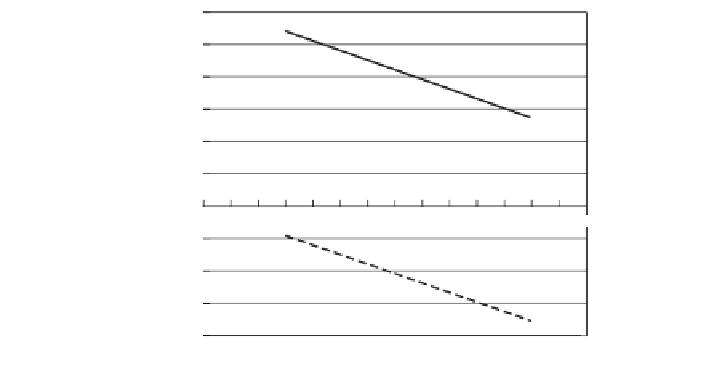Agriculture Reference
In-Depth Information
1200
1000
800
600
400
200
O
2
H
2
O
0
0
1
2
3
4
5
6
7
8
9
10
11
12
13
14
-200
-400
-600
-800
H
2
pH
Figure 5.3.
Electrode potentials for the oxidation of oxygen and the reduction of hydrogen at
gaseous pressure of 1 atm and pH levels common in soil.
rainfall or irrigation events and the subsequent percolation of water through
the soil profile. It will be more pronounced in soils, such as
Aridisols
, which
naturally contain more salts and soil with more clays, that is, with Bt horizons,
particularly for high-activity clays, with high cation exchange capacity and high
surface area.
5.3.
POTENTIOMETRY (ELECTRODES IN SOIL MEASUREMENTS)
Numerous different types of electrodes are used in electrochemical analysis
of soil. Simple elemental electrodes such as platinum, mercury, and carbon are
the most frequently used, while other unreactive metals such as gold and silver
and the more reactive copper and zinc and others have been used. During
analysis both stirred and unstirred solutions and suspensions are used. In some
cases electrodes are rotated or, in the case of mercury, dropped into the solu-
tion being analyzed.
Soil scientists represent the electrode potential as Eh and the standard
potential as Eh
0
,
1
which is measured in millivolts or volts. All (non-oven-dried)
soil contains water, which limits the possible upper and lower potentials. The
upper potential is controlled by the oxidation of water. Under highly oxidiz-
ing conditions oxygen would be oxidized to oxygen gas, namely, O
2
. The lower
potential is limited by the reduction of hydrogen or protons, specifically, H
+
,
which would lead to the formation of hydrogen gas. Figure 5.3 shows the elec-
1
The standard electrode potential is that potential generated by an electrode when compared to
a standard hydrogen electrode under standard conditions, which typically include a temperature
of 298 K (degrees Kelvin).

